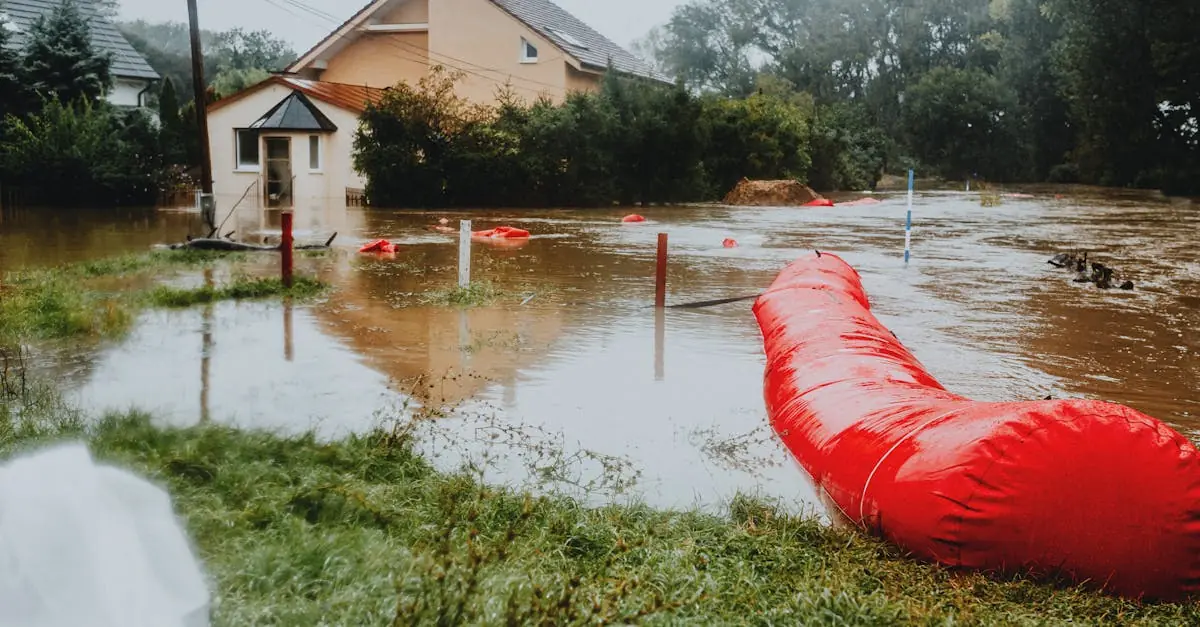Table of Contents
ToggleNavigating the world of construction permits can feel like trying to assemble IKEA furniture without the instructions—confusing and a bit frustrating. Each state has its own set of rules and regulations, making it crucial for builders and DIY enthusiasts to know what to expect. After all, nobody wants to find out they’ve built their dream deck only to be told it’s a no-go by the local authorities.
Overview Of Construction Permits By State
Obtaining construction permits varies significantly across the United States. Each state enforces its own set of regulations, making the process unique. Builders often face different requirements depending on location, which can impact project timelines and costs.
In California, for instance, a rigorous permit process exists that emphasizes environmental compliance. This state prioritizes sustainable building practices, requiring additional approvals for certain projects. Meanwhile, Texas typically has a more streamlined approach, with fewer regulations on residential construction permits.
Florida mandates permits for all construction, influenced by its susceptibility to hurricanes. The state enforces rigorous building codes, ensuring structures withstand extreme weather conditions. Conversely, some states, like Wyoming, have fewer restrictions, facilitating easier access to permits for various construction projects.
When analyzing permits, the type of construction also matters. Commercial projects usually require a more complex approval process compared to residential projects. Many states classify permits into categories that expedite processing for smaller, less impactful construction.
Understanding local regulations remains essential. Builders and DIY enthusiasts must research specific permit requirements in their respective states to avoid fines and project delays. Websites like state government pages often provide resources that outline these regulations, making it easier for individuals to navigate the permit landscape.
Permits play a vital role in maintaining safety and regulatory standards. Without proper permitting, individuals risk penalties and future complications when selling properties. Recognizing the complexities involved in obtaining construction permits by state aids in efficient project management and compliance.
Importance Of Construction Permits
Construction permits play a critical role in ensuring safety and compliance for building projects. These permits serve as formal approvals from local authorities, allowing construction to commence while adhering to specific regulations.
Enhancing Safety Standards
Safety standards require rigorous enforcement, and construction permits support this need. Permits verify that builders meet established codes aimed at protecting the well-being of occupants and the public. Local authorities assess plans for structural integrity, fire safety, and accessibility. Inspections during construction help monitor adherence to these standards. By promoting safe building practices, permits minimize hazards, reducing risks of accidents and injuries on job sites.
Promoting Compliance
Compliance with legal requirements hinges on obtaining construction permits. Following state-specific regulations prevents fines and legal complications. Builders must submit detailed plans, ensuring alignment with zoning laws and environmental guidelines. Permits illustrate a commitment to upholding community standards and preserving neighborhood integrity. They facilitate a smoother inspection process, enhancing project timelines. Building without necessary permits poses serious challenges, often resulting in costly penalties and potential project halts. Therefore, understanding compliance impacts every aspect of construction management.
State-Specific Permit Requirements
Understanding state-specific permit requirements is essential for anyone planning construction projects. Each state’s regulations vary, impacting approval timelines and costs.
West Coast States
California, Oregon, and Washington impose strict environmental regulations. California requires numerous permits focused on sustainability. Oregon’s local jurisdictions demand compliance with specific zoning laws. Washington enforces building codes to withstand seismic activity. Builders must check local jurisdictions for unique requirements to avoid delays.
East Coast States
States like New York, New Jersey, and Florida have diverse permit processes. New York mandates detailed plans before issuing construction permits. New Jersey enforces strict building codes due to regulatory standards. Florida’s hurricane-prone areas require additional permits for wind-resistant designs. Thorough research of local laws helps in navigating these regulations.
Midwest States
Wisconsin, Illinois, and Michigan showcase a balanced approach to permits. Wisconsin emphasizes agricultural considerations in its regulations. Illinois requires permits for both commercial and residential projects, focusing on safety and accessibility. Michigan offers online resources for builders to streamline the application process. Familiarity with state laws can ease compliance.
Southern States
Texas, Florida, and Georgia present diverse construction permits. Texas maintains a more streamlined approach that simplifies the process. Florida, as noted earlier, prioritizes safety due to hurricanes. Georgia requires permits for all projects, emphasizing local building codes. Builders should engage local authorities early in the process to ensure all requirements are met.
Common Challenges In Obtaining Permits
Obtaining construction permits presents several challenges that can complicate project timelines and costs. Builders often encounter significant obstacles as they navigate local regulations.
Bureaucratic Delays
Bureaucratic delays frequently affect permit approval processes. Confusion arises when applications pile up at local offices, prolonging waiting times. Local authorities prioritize certain projects, which can shift attention away from others. Additionally, administrative inefficiencies can result in longer processing times. In many cases, permit approvals stall due to a lack of staffing or resources, leaving builders in limbo. As a consequence, understanding these potential delays allows builders to plan projects more effectively.
Misunderstandings And Miscommunication
Misunderstandings and miscommunication often occur between builders and local authorities. Builders may misinterpret local regulations, leading to improper applications. Conversely, authorities sometimes fail to communicate updates or changes in regulations. Clear guidelines can be elusive, resulting in incomplete submissions and requests for additional information. Poor communication can contribute to heightened frustration and unnecessary delays. Recognizing the importance of clear dialogue helps builders mitigate these issues.
Tips For Navigating The Permit Process
Research local regulations early. Understanding specific requirements in each state helps avoid complications and delays. Builders should consult local authorities to gain insights into the permitting process relevant to their project type.
Prepare documentation meticulously. Ensuring all plans, specifications, and necessary documents are complete reduces the possibility of miscommunication. Each state may require different forms or details that builders must include in their submissions.
Establish clear lines of communication with local officials. Regularly engaging with permitting offices fosters a collaborative environment and facilitates quicker approvals. Builders should seek clarification on any confusing regulations to prevent unnecessary setbacks.
Anticipate potential delays. Bureaucratic inefficiencies often impact approval timelines, so builders should account for this in their project schedules. Creating a buffer period for permit acquisition can help manage expectations and keep projects on track.
Track all correspondence and submissions. Maintaining a detailed record of interactions with permitting agencies aids in resolving any future discrepancies. Having a clear timeline of submitted applications and responses helps builders stay organized and informed.
Keep abreast of revisions in regulations. State requirements may evolve, impacting ongoing and future projects. Regularly checking for updates ensures compliance with the latest codes and standards, mitigating risks of penalties.
Engage professionals when necessary. Hiring experienced consultants can provide expert guidance to navigate complicated regulations. Their insights significantly streamline the permit process, especially in states with intricate compliance requirements.
Conclusion
Navigating the landscape of construction permits is crucial for anyone involved in building projects. Each state presents its own set of regulations that can significantly influence timelines and costs. By understanding these requirements and engaging with local authorities early on, builders can avoid unnecessary complications.
Effective communication and thorough research are key elements in ensuring compliance. As the construction industry continues to evolve, staying informed about permit processes will remain essential for successful project execution. Ultimately, a proactive approach to securing permits not only fosters safety and adherence to standards but also enhances the overall efficiency of construction endeavors.








